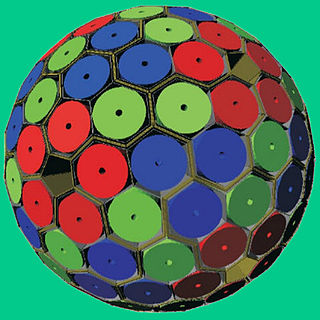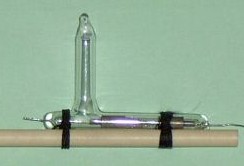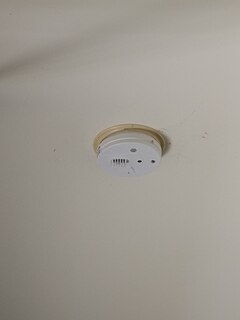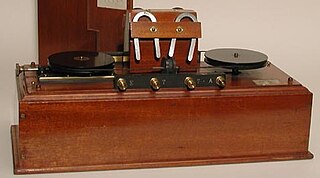 W
WAGATA, for advanced gamma tracking array, is a highly developed detector system to track gamma rays. It is a European collaboration project funded by twelve countries in Europe. The project was proposed in 2001 and in 2002 it was signed by the participant countries; in 2005 the first detector showed its result. It is expected that the complete AGATA will be ready within 2018. The spectrometer is 4π gamma-ray detector which is a combination of several Germanium detectors (Ge-detector). It is a major instrument to study nuclear structure ray tracking by measuring the γ-radiation. AGATA will have very good full energy peak efficiency with high peak-to-total ratio (P/T) and angular resolution. The system will be capable of high event rates with ancillary detectors to measure light charged particles or neutron.
 W
WThe Artyomovsk scintillation detector (ASD) is a 100-ton scintillation underground detector that was created in the Department of High-Energy Leptons and Neutrino Astrophysics of the Institute of Nuclear Research of the USSR Academy of Sciences in 1969 to study:
 W
WAn aspirating smoke detector (ASD) is a system used in active fire protection, consisting of a central detection unit which draws air through a network of pipes to detect smoke. The sampling chamber is based on a nephelometer that detects the presence of smoke particles suspended in air by detecting the light scattered by them in the chamber. ASDs can typically detect smoke before it is visible to the naked eye.
 W
WA bat detector is a device used to detect the presence of bats by converting their echolocation ultrasound signals, as they are emitted by the bats, to audible frequencies, usually about 120 Hz to 15 kHz. There are other types of detectors which record bat calls so that they can be analysed afterward, but these are more commonly referred to by their particular function.
 W
WBeta attenuation monitoring (BAM) is a widely used air monitoring technique employing the absorption of beta radiation by solid particles extracted from air flow. This technique allows for the detection of PM10 and PM2.5, which are monitored by most air pollution regulatory agencies. The main principle is based on a kind of Bouguer (Lambert–Beer) law: the amount by which the flow of beta radiation (electrons) is attenuated by a solid matter is exponentially dependent on its mass and not on any other feature (such as density, chemical composition or some optical or electrical properties) of this matter. So, the air is drawn from outside of the detector through an "infinite" (cycling) ribbon made from some filtering material so that the particles are collected on it. There are two sources of beta radiation placed one before and one after the region where air flow passes through the ribbon leaving particles on it; and there are also two detectors on the opposite side of the ribbon, facing the detectors. The sources' intensity and detectors' sensitivity being the same (or corrected with appropriate calibration lookup table), the intensity of beta rays detected by one of detectors is compared to that of the other. Thus one can deduce how much mass has the ribbon acquired upon being exposed to air flow; knowing the drain velocity, actual particle mass concentration in air could be assessed.
 W
WA carbon monoxide detector or CO detector is a device that detects the presence of the carbon monoxide (CO) gas to prevent carbon monoxide poisoning. In the late 1990s Underwriters Laboratories changed the definition of a single station CO detector with a sound device to carbon monoxide (CO) alarm. This applies to all CO safety alarms that meet UL 2034 standard; however for passive indicators and system devices that meet UL 2075, UL refers to these as carbon monoxide detectors.
 W
WThe coherer was a primitive form of radio signal detector used in the first radio receivers during the wireless telegraphy era at the beginning of the 20th century. Its use in radio was based on the 1890 findings of French physicist Édouard Branly and adapted by other physicists and inventors over the next ten years. The device consists of a tube or capsule containing two electrodes spaced a small distance apart with loose metal filings in the space between. When a radio frequency signal is applied to the device, the metal particles would cling together or "cohere", reducing the initial high resistance of the device, thereby allowing a much greater direct current to flow through it. In a receiver, the current would activate a bell, or a Morse paper tape recorder to make a record of the received signal. The metal filings in the coherer remained conductive after the signal (pulse) ended so that the coherer had to be "decohered" by tapping it with a clapper actuated by an electromagnet, each time a signal was received, thereby restoring the coherer to its original state. Coherers remained in widespread use until about 1907, when they were replaced by more sensitive electrolytic and crystal detectors.
 W
WA crystal detector is an obsolete electronic component used in some early 20th century radio receivers that consists of a piece of crystalline mineral which rectifies the alternating current radio signal and was employed as a detector (demodulator) to extract the audio modulation to produce the sound in the earphones. It was the first type of semiconductor diode, and one of the first semiconductor electronic devices. The most common type was the so-called cat whisker detector, which consisted of a piece of crystalline mineral, usually galena, with a fine wire touching its surface.
 W
WIn radio, a detector is a device or circuit that extracts information from a modulated radio frequency current or voltage. The term dates from the first three decades of radio (1888-1918). Unlike modern radio stations which transmit sound on an uninterrupted carrier wave, early radio stations transmitted information by radiotelegraphy. The transmitter was switched on and off to produce long or short periods of radio waves, spelling out text messages in Morse code. Therefore, early radio receivers had only to distinguish between the presence or absence of a radio signal. The device that performed this function in the receiver circuit was called a detector. A variety of different detector devices, such as the coherer, electrolytic detector, magnetic detector and the crystal detector, were used during the wireless telegraphy era until superseded by vacuum tube technology.
 W
WThe electrolytic detector, or liquid barretter, was a type of detector (demodulator) used in early radio receivers. First used by Canadian radio researcher Reginald Fessenden in 1903, it was used until about 1913, after which it was superseded by crystal detectors and vacuum tube detectors such as the Fleming valve and Audion (triode). It was considered very sensitive and reliable compared to other detectors available at the time such as the magnetic detector and the coherer. It was one of the first rectifying detectors, able to receive AM (sound) transmissions. On December 24, 1906, US Naval ships with radio receivers equipped with Fessenden's electrolytic detectors received the first AM radio broadcast from Fessenden's Brant Rock, Massachusetts transmitter, consisting of a program of Christmas music.
 W
WAn envelope detector is an electronic circuit that takes a (relatively) high-frequency amplitude modulated signal as input and provides an output which is the demodulated envelope of the original signal.
 W
WA gas detector is a device that detects the presence of gases in an area, often as part of a safety system. This type of equipment is used to detect a gas leak or other emissions and can interface with a control system so a process can be automatically shut down. A gas detector can sound an alarm to operators in the area where the leak is occurring, giving them the opportunity to leave. This type of device is important because there are many gases that can be harmful to organic life, such as humans or animals.
 W
WA glass break detector is a sensor used in electronic burglar alarms that detects if a pane of glass is shattered or broken. These sensors are commonly used near glass doors or glass store-front windows.
 W
WA heat detector is a fire alarm device designed to respond when the convected thermal energy of a fire increases the temperature of a heat sensitive element. The thermal mass and conductivity of the element regulate the rate flow of heat into the element. All heat detectors have this thermal lag. Heat detectors have two main classifications of operation, "rate-of-rise" and "fixed temperature". The heat detector is used to help in the reduction of property damage.
 W
WAn infrared detector is a detector that reacts to infrared (IR) radiation. The two main types of detectors are thermal and photonic (photodetectors).
 W
WThe magnetic detector or Marconi magnetic detector, sometimes called the "Maggie", was an early radio wave detector used in some of the first radio receivers to receive Morse code messages during the wireless telegraphy era around the turn of the 20th century. Developed in 1902 by radio pioneer Guglielmo Marconi from a method invented in 1895 by New Zealand physicist Ernest Rutherford it was used in Marconi wireless stations until around 1912, when it was superseded by vacuum tubes. It was widely used on ships because of its reliability and insensitivity to vibration. A magnetic detector was part of the wireless apparatus in the radio room of the RMS Titanic which was used to summon help during its famous 15 April 1912 sinking.
 W
WMedipix is a family of photon counting and particle tracking pixel detectors developed by an international collaboration, hosted by CERN.
 W
WThe non-linear junction detector, or an NLJD, is a device that illuminates a small region of space with high-frequency RF energy. Any "non linear junction" in the vicinity—for example, and particularly, the p-n junction—will receive this energy, and because of the asymmetric response of the junction to an electric field, it will mangle it, re-emitting some of it on multiples of the illumination frequency. The detector has a sensitive receiver tuned to these harmonics, as well as appropriate processing and displays to make their presence known to the user of the device. Because the basis of almost all semiconductor electronics is the p-n junction, an NLJD is correspondingly capable of detecting almost any unshielded electronic device containing semiconductors, whether the electronics are actively powered or not.
 W
WAn optical beam smoke detector is a device that uses a projected beam of light to detect smoke across large areas, typically as an indicator of fire. They are used to detect fires in buildings where standard point smoke detectors would either be uneconomical or restricted for use by the height of the building. Optical beam smoke detectors are often installed in warehouses as a cost-effective means of protecting large open spaces.
 W
WPILATUS is the name of a series of x-ray detectors originally developed by the Paul Scherrer Institute at the Swiss Light Source and further developed and commercialized by DECTRIS. The PILATUS detectors are based on hybrid photon counting (HPC) technology, by which X-rays are converted to electrical signals by the photoelectric effect in a semiconductor sensor layer—either silicon or cadmium telluride—which is subject to a substantial bias voltage. The electric signals are counted directly by a series of cells in an ASIC bonded to the sensor. Each cell—or pixel—is a complete detector in itself, equipped with an amplifier, discriminator and counter circuit. This is possible thanks to contemporary CMOS integrated circuit technology.
 W
WA radar detector is an electronic device used by motorists to detect if their speed is being monitored by police or law enforcement using a radar gun. Most radar detectors are used so the driver can reduce the car's speed before being ticketed for speeding. In general sense, only emitting technologies, like doppler RADAR, or LIDAR can be detected. Visual speed estimating techniques, like ANPR or VASCAR can not be detected in daytime, but technically vulnerable to detection at night, when IR spotlight is used. There are no reports that piezo sensors can be detected. LIDAR devices require an optical-band sensor, although many modern detectors include LIDAR sensors. Most of today's radar detectors detect signals across a variety of wavelength bands: usually X, K, and Ka. In Europe the Ku band is common as well. The past success of radar detectors was based on the fact that radio-wave beam can not be narrow-enough, so the detector usually senses stray and scattered radiation, giving the driver time to slow down. Based on a focused laser-beam, LIDAR technology does not suffer this shortcoming; however it requires precise aiming. Modern police radars incorporate formidable computing power, producing a minimum number of ultra-short pulses, reusing wide beams for multi-target measurement, which renders most detectors useless. But, mobile Internet allows GPS navigation devices to map police radar locations in real-time. These devices are also often called "radar detectors", while not necessary carrying an RF sensor.
 W
WThe ratio detector is a type of detector circuit, commonly used in radio receivers for demodulating frequency modulated (FM) signal.
 W
WA Readout integrated circuit (ROIC) is an integrated circuit (IC) specifically used for reading detectors of a particular type. They are compatible with different types of detectors such as infrared and ultraviolet. The primary purpose for ROICs is to accumulate the photocurrent from each pixel and then transfer the resultant signal onto output taps for readout. Conventional ROIC technology stores the signal charge at each pixel and then routes the signal onto output taps for readout. This requires storing large signal charge at each pixel site and maintaining signal-to-noise ratio as the signal is read out and digitized.
 W
WA smoke detector is a device that senses smoke, typically as an indicator of fire. Commercial security devices issue a signal to a fire alarm control panel as part of a fire alarm system, while household smoke detectors, also known as smoke alarms, generally issue a local audible or visual alarm from the detector itself or several detectors if there are multiple smoke detectors interlinked.
 W
WA window detector circuit, also called window comparator circuit or dual edge limit detector circuits is used to determine whether an unknown input is between two precise reference threshold voltages. It employs two comparators to detect over-voltage or under-voltage.
 W
WX-ray detectors are devices used to measure the flux, spatial distribution, spectrum, and/or other properties of X-rays.